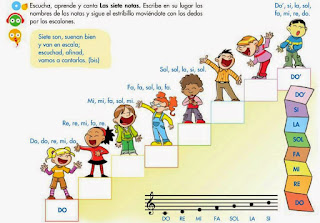This is the story of Peter and the wolf. (Serguéi Prokófiev 1891-1953)
Each character in the tale is going to be represented by a
different instrument of the orchestra. For instance, the bird will
be played by the flute. (Like this.) Here's the duck, played by
the oboe. The cat by the clarinet. The bassoon will represent
grandfather. The wolf by the French horns. And Peter by the
strings. The blast of the hunters' shotguns played by the kettle
drums.
Are you sitting comfortably? Then I shall begin.
Early one morning, Peter opened the gate and went out into the big
green meadow.
On a branch of a big tree sat a little bird, Peter's friend. "All
is quiet, All is quiet" chirped the bird gaily. Yes all is quiet.
Just then a duck came waddling round. She was glad that Peter
hadn't closed the gate and decided to take a nice swim in the deep
pond in the meadow.
Seeing the duck, the little bird flew down upon on the grass,
settled next to her and shrugged his shoulders. "What kind of bird
are you if you can't fly?" said he. To this the duck replied "What
kind of bird are you if you can't swim?" and dived into the pond.
They argued and argued, the duck swimming in the pond and the
little bird hopping along the shore.
Suddenly, something caught Peter's attention. It was a cat
crawling through the grass.
The cat thought; "The bird is busy arguing, I'll just grab him.
Stealthily she crept towards him on his velvet paws.
"Look out!" shouted Peter and the bird immediately flew up into
the tree, while the duck quacked at the cat, from the middle of
the pond. The cat walked around the tree and thought, "Is it worth
climbing up so high? By the time I get there the bird will have
flown away."
Just then grandfather came out. He was angry because Peter had
gone in the meadow. "It is the dangerous place. If a wolf should
come out of the forest, then what would you do?"
But Peter paid no attention to his grandfather's words. Boys like
Peter aren't afraid of wolves.
But grandfather took Peter by the hand, locked the gate and led
him home.
No sooner had Peter gone, than a big grey wolf came out of the
forest.
In a twinkling the cat climbed up into the tree. The duck quacked,
and in her excitement jumped out of the pond. But no matter how
hard the duck tried to run, she couldn't escape the wolf.
He was getting nearer, nearer, catching up with her. Then he got
her and with one gulp swallowed her.
And now, this is how things stood: the cat was sitting on one
branch, the bird on another, not too close to the cat.
And the wolf walked round and round the tree, looking at them with
hungry eyes.
In the meantime, Peter, without the slightest fear, stood behind
the gate watching all that was going on.
He ran home, got a strong rope. and climbed up the high stone
wall.
One of the branches of the tree around which the wolf was walking
stretched out over the wall.
Grabbing hold of the branch, Peter lightly climbed over on to the
tree. Peter said to the bird: "Fly down and circle over the
wolf's head. Only take care that he doesn't catch you."
The bird almost touched the wolf's head with his wings while the
wolf snapped angrily at him, this side and that.
How that bird teased the wolf! And how the wolf wanted to catch
him! But the bird was clever, and the wolf simply couldn't do
anything about it.
Meanwhile, Peter made a lasso and carefully letting it down and
down and down, caught the wolf by the tail and pulled with all his
might.
Feeling himself caught, the wolf began to jump wildly trying to
get loose.
But Peter tied the other end of rope to the tree, and the wolf's
jumping only made the rope round his tail tighter.
Just then the hunters came out of the woods, following the wolf's
trail and shooting as they went.
But Peter, sitting in the tree, said: "Don't shoot! Birdie and I
have already caught the wolf. Now help us take him to the zoo."
Now just imagine, just imagine the triumphant procession. Peter at
the head. After him the hunters leading the wolf. And winding up
the whole procession grandfather and the cat.
Grandfather shook his head discontentedly. "Well, if Peter hadn't
caught the wolf? What's then?"
Above them flew Birdie chirping merrily. "My, what brave fellows
we are, Peter and I! Look what we have caught!"
And if one would listen very carefully, he would hear the duck
quacking inside the wolf, because the wolf, in his hurry, had
swallowed her alive.









